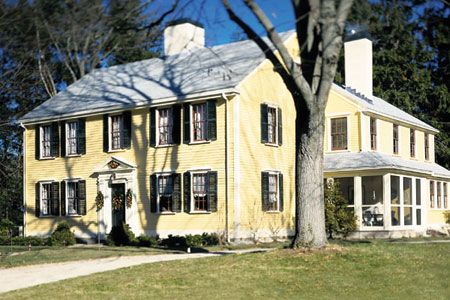
We began the Milton project with a structure full of leaks. It was so drafty that a blower-door test—essentially a big fan that sucks air out of the house—indicated that on an average breezy day, the building’s air was changed over 10 times an hour. As the technician said. “You might as
well be standing outside.” In the name of energy efficiency and occupant comfort, we called in the foam insulation trucks, which left behind a building as snug as a thermos bottle.
In fact, it was so tightly insulated that we confronted a new challenge, one facing owners of many new homes and those with renovated ones like ours in Milton. With drafts at a bare minimum, the risk is that, like a thermos bottle, the house will trap all the moisture produced by its occupants — from cooking to washing clothes to breathing. If that moisture were to condense, as it would at any cold point in the building envelope, rot would be sure to follow.
A strong ventilation system was the answer, and its secret weapon was a heat-recovery ventilator, aka an air-to-air heat exchanger. The goal was to rid the house of its stale, moist air while keeping as much of
that air’s heat as possible. Here’s how it works: Installed in the attic, operating continuously, the unit sucks air through ducts positioned in three of the prime generators of moisture and odor — two bathrooms and the kitchen. As the air flows out to an exterior vent, it passes through a metal box containing a matrix of crimped aluminum plates, full of air channels. At the same time, fresh outdoor air is being sucked into the building, passing through the same box on its way to outlets located in two central locations. Channels handling the outbound air alternate with channels handling the inbound. The two airstreams never mix, but as they pass each other, heat migrates from the warm outbound stream to the cool inbound, preheating it and reducing load on the heating plant. In the summer, the system works in reverse, using the house’s cooler conditioned air to strip off some of the incoming fresh air’s heat, precooling it and reducing load on the air-conditioning system.
The cost: about $3,000. The result: 80 percent of the heat is either “recovered” or “stripped,” damaging moisture and offensive odors are eliminated, and the occupants enjoy the same kind of fresh air inside as their predecessors, sans the drafts and the bills.
Heat-recovery ventilators can be retrofitted in homes with ducted heating systems. Most contain air filters, some have dehumidifiers built in. They are particularly effective in northern climates (and are in fact required equipment in new Canadian homes), though research shows they can make sense in climates where air-conditioning is the predominant concern.

